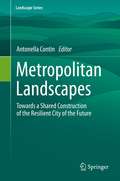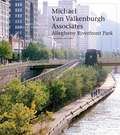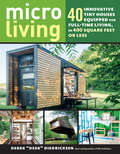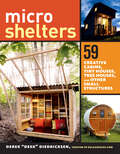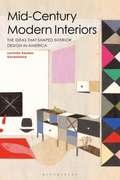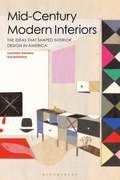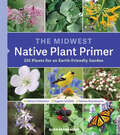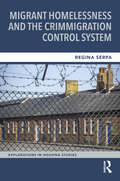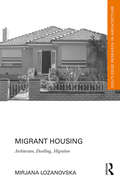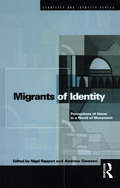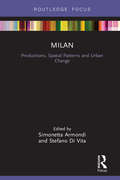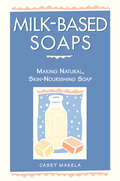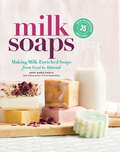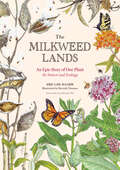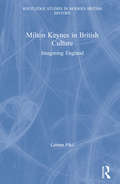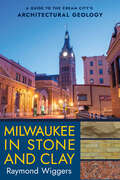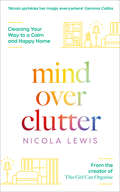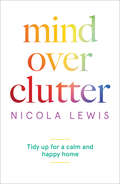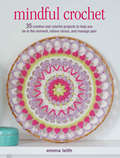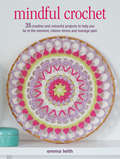- Table View
- List View
Metropolitan Landscapes: Towards a Shared Construction of the Resilient City of the Future (Landscape Series #28)
by Antonella ContinThis edited volume covers many aspects of the Metropolitan Landscapes. Solutions are needed to meet the demand of the citizens of a renewed metropolitan region landscape. It opens up discussions about possible toolkits for strategic actions based on understanding the territory from geographical, urban, architectural, economic, environmental, and public policy perspectives. This book intends to promote the Metropolitan dwelling quality, ensuring human well-being proposing a discussion on the resilient articulation of the interface space among the city's infrastructure, agriculture, and nature.This book results from the Symposium: Metropolitan Landscapes that MSLab of the Politecnico di Milano and ETSA (Sevilla) organized at the IALE 2019 Conference (Milan, July 2019) to manage radical territory transformation with a strategic vision. The widespread growth of urban areas indicates the importance of building resilient sustainable cities capable of minimizing climate-change impact production.The Symposium aimed to discuss the Urban Metabolism approach considering the combination of Landscapes set in a single Metropolitan Ecosystem. Accordingly, new design strategies of transformation, replacement or maintenance can compose Urban-Rural Linkage patterns and a decalage of different landscape contexts. Ecological interest in environmental sustainability, compatibility, and resilience is not tied exclusively to the balance between production and energy consumption. Thus, it is the integration over time and at several scales of the urban and rural landscapes and their inhabitants that nourish the Metropolitan Bioregion.Moreover, the Metropolitan Landscape Book's research hypothesis is the need for a Glossary, strengthening the basis of understanding Metropolitan Landscape's complexity.This book's topic is particularly relevant to Landscape Urbanism, Architecture, Urban disciplines Scholars, Students and Practitioners who want to be connected in a significant way with Metropolitan Discipline’s research field.
Michael Van Valkenburgh Associates: Allegheny Riverfront Park (Source Books in Landscape Architecture #1)
by Jane AmidonIn the field of landscape architecture, there is no more distinguished voice than Michael Van Valkenburgh, and it therefore seems appropriate that we begin this new Source Books in Landscape series with his recently completed Allegheny Riverfront Park project for Pittsburgh, Pennsylvania. As part of the city’s efforts to restore its downtown district and riverfront, Van Valkenburgh, along with artists Ann Hamilton and Michael Mercil, developed an ambitious plan to reform the wasted land along the river into an urban refuge. The celebrated collaboration between landscape architect and artist produced a thoughtful, useful, and beautiful park that has successfully renewed the city’s core. Source Books in Landscape Architecture, produced in collaboration with Ohio State University, will provide detailed documentation of important new projects, following its development from conception through completion using sketches, drawings, models, renderings, working drawings, and photographs.
Micro Living: 40 Innovative Tiny Houses Equipped for Full-Time Living, in 400 Square Feet or Less
by Derek “Deek” DiedricksenLive tiny without sacrificing the comforts of home with Derek &“Deek&” Diedricksen&’s lively exploration of 40 small dwellings outfitted with features essential to full-time, year-round living — complete with floor plans, real experiences, and expert tips from tiny house residents.
Microshelters: 59 Creative Cabins, Tiny Houses, Tree Houses, and Other Small Structures
by Derek “Deek” DiedricksenDiscover how "big" tiny can be! With stunning photographs, fascinating information, and plans to build your own, Microshelters proves that small structures are not only useful, but stylish as well.
Mid-Century Modern Interiors: The Ideas that Shaped Interior Design in America
by Lucinda Kaukas HavenhandMid-Century Modern Interiors explores the history of interior design during arguably its most iconic and influential period. The 1930s to the 1960s in the United States was a key moment for interior design. It not only saw the emergence of some of interior design's most globally-important designers, it also saw the field of interior design emerge at last as a profession in its own right. Through a series of detailed case studies this book introduces the key practitioners of the period – world-renowned designers including Ray and Charles Eames, Richard Neutra, and George Nelson – and examines how they developed new approaches by applying systematic and rational principles to the creation of interior spaces. It takes us into the mind of the designer to show how they each used interior design to express their varied theoretical interests, and reveals how the principles they developed have become embodied in the way interior design is practiced today. This focus on unearthing the underlying ideas and concepts behind their designs rather than on the finished results creates a richer, more conceptual understanding of this pivotal period in modernist design history.With an extended introduction setting the case studies within the broader context of twentieth-century design and architectural history, this book provides both an introduction and an in-depth analysis for students and scholars of interior design, architecture and design history.
Mid-Century Modern Interiors: The Ideas that Shaped Interior Design in America
by Lucinda Kaukas HavenhandMid-Century Modern Interiors explores the history of interior design during arguably its most iconic and influential period. The 1930s to the 1960s in the United States was a key moment for interior design. It not only saw the emergence of some of interior design's most globally-important designers, it also saw the field of interior design emerge at last as a profession in its own right. Through a series of detailed case studies this book introduces the key practitioners of the period – world-renowned designers including Ray and Charles Eames, Richard Neutra, and George Nelson – and examines how they developed new approaches by applying systematic and rational principles to the creation of interior spaces. It takes us into the mind of the designer to show how they each used interior design to express their varied theoretical interests, and reveals how the principles they developed have become embodied in the way interior design is practiced today. This focus on unearthing the underlying ideas and concepts behind their designs rather than on the finished results creates a richer, more conceptual understanding of this pivotal period in modernist design history.With an extended introduction setting the case studies within the broader context of twentieth-century design and architectural history, this book provides both an introduction and an in-depth analysis for students and scholars of interior design, architecture and design history.
The Midwest Native Plant Primer: 225 Plants for an Earth-Friendly Garden
by Alan BranhagenMore homeowners than ever before are adding native plants to their gardens. This book shares the best plant choices for the Midwest and details how gardeners can grow them successfully.
Migrant Homelessness and the Crimmigration Control System (ISSN)
by Regina SerpaMigrant Homelessness and the Crimmigration Control System offers new insights into the drivers of homelessness following migration by unpacking the housing consequences of ‘crimmigration’ control systems in the US and the UK. The book advances ‘housing sacrifice’ as a concept to understand journeys in and out of homelessness and the coping strategies migrants employ. Undergirded by persuasive empirical research, it offers a compelling case for a ‘social citizenship’ right to housing guaranteed across social, political and civil realms of society. The book is structured around the 30 life stories of people who have migrated to the capital cities of Boston and Edinburgh from Central America and Eastern Europe. The narratives are complemented by interviews with a range of stakeholders (including frontline caseworkers, activists and policymakers). Guided by the tenets of critical realist theory, this book offers a biographical inquiry into the intersections of race, class and gender and provides insight into the everyday precarity homeless migrants face, by listening to them directly. It will be of interest to students, scholars, and policymakers across a range of fields including housing, immigration, criminology, sociology, and human geography.
Migrant Homelessness and the Crimmigration Control System (ISSN)
by Regina SerpaMigrant Homelessness and the Crimmigration Control System offers new insights into the drivers of homelessness following migration by unpacking the housing consequences of ‘crimmigration’ control systems in the US and the UK. The book advances ‘housing sacrifice’ as a concept to understand journeys in and out of homelessness and the coping strategies migrants employ. Undergirded by persuasive empirical research, it offers a compelling case for a ‘social citizenship’ right to housing guaranteed across social, political and civil realms of society. The book is structured around the 30 life stories of people who have migrated to the capital cities of Boston and Edinburgh from Central America and Eastern Europe. The narratives are complemented by interviews with a range of stakeholders (including frontline caseworkers, activists and policymakers). Guided by the tenets of critical realist theory, this book offers a biographical inquiry into the intersections of race, class and gender and provides insight into the everyday precarity homeless migrants face, by listening to them directly. It will be of interest to students, scholars, and policymakers across a range of fields including housing, immigration, criminology, sociology, and human geography.
Migrant Housing: Architecture, Dwelling, Migration (Routledge Research in Architecture)
by Mirjana LozanovskaMigrant Housing, the latest book by author Mirjana Lozanovska, examines the house as the architectural construct in the processes of migration. Housing is pivotal to any migration story, with studies showing that migrant participation in the adaptation or building of houses provides symbolic materiality of belonging and the platform for agency and productivity in the broader context of the immigrant city. Migration also disrupts the cohesion of everyday dwelling and homeland integral to housing, and the book examines this displacement of dwelling and its effect on migrant housing. This timely volume investigates the poetic and political resonance between migration and architecture, challenging the idea of the ‘house’ as a singular theoretical construct. Divided into three parts, Histories and theories of post-war migrant housing, House/home and Mapping migrant spaces of home, it draws on data studies from Australia and Macedonia, with literature from Canada, Sweden and Germany, to uncover the effects of unprivileged post-war migration in the late twentieth century on the house as architectural and normative model, and from this perspective negotiates the disciplinary boundaries of architecture.
Migrant Housing: Architecture, Dwelling, Migration (Routledge Research in Architecture)
by Mirjana LozanovskaMigrant Housing, the latest book by author Mirjana Lozanovska, examines the house as the architectural construct in the processes of migration. Housing is pivotal to any migration story, with studies showing that migrant participation in the adaptation or building of houses provides symbolic materiality of belonging and the platform for agency and productivity in the broader context of the immigrant city. Migration also disrupts the cohesion of everyday dwelling and homeland integral to housing, and the book examines this displacement of dwelling and its effect on migrant housing. This timely volume investigates the poetic and political resonance between migration and architecture, challenging the idea of the ‘house’ as a singular theoretical construct. Divided into three parts, Histories and theories of post-war migrant housing, House/home and Mapping migrant spaces of home, it draws on data studies from Australia and Macedonia, with literature from Canada, Sweden and Germany, to uncover the effects of unprivileged post-war migration in the late twentieth century on the house as architectural and normative model, and from this perspective negotiates the disciplinary boundaries of architecture.
Migrants of Identity: Perceptions of 'Home' in a World of Movement
by Andrew Dawson Nigel RapportGlobal movement is commonly characterized as one of the quintessential experiences of our age. Market forces, territorial conflicts and environmental changes uproot an increasing number of people, while mass communication, travel, tourism, and a global market of commodities, texts, tastes, fashions and ideologies place individuals more than ever in a global arena. As traditional conceptions of individuals as members of stationary, fixed and separate societies and cultures no longer convince, to what extent does movement become central to individuals' self-conceptions? How do people cultivate, negotiate, nurture and maintain an identity? To what extent do individuals become ‘migrants of identity' whose home is movement?Defining ‘home' as ‘where one best knows oneself', this pioneering book explores the various ways in which people perceive themselves to be ‘at home' in today's world. Through a series of case studies, authors show that for a world of travellers, labour migrants, exiles and commuters, ‘home' comes to be found in behavioural routines and techniques, in styles of dress and address, in memories, myths and stories, in jokes and opinions. In short, people who live their lives in movement make sense of their lives as movement.
Migrants of Identity: Perceptions of 'Home' in a World of Movement (Ethnicity And Identity Ser.)
by Nigel RapportGlobal movement is commonly characterized as one of the quintessential experiences of our age. Market forces, territorial conflicts and environmental changes uproot an increasing number of people, while mass communication, travel, tourism, and a global market of commodities, texts, tastes, fashions and ideologies place individuals more than ever in a global arena. As traditional conceptions of individuals as members of stationary, fixed and separate societies and cultures no longer convince, to what extent does movement become central to individuals' self-conceptions? How do people cultivate, negotiate, nurture and maintain an identity? To what extent do individuals become ‘migrants of identity' whose home is movement?Defining ‘home' as ‘where one best knows oneself', this pioneering book explores the various ways in which people perceive themselves to be ‘at home' in today's world. Through a series of case studies, authors show that for a world of travellers, labour migrants, exiles and commuters, ‘home' comes to be found in behavioural routines and techniques, in styles of dress and address, in memories, myths and stories, in jokes and opinions. In short, people who live their lives in movement make sense of their lives as movement.
Milan: Productions, Spatial Patterns and Urban Change (Built Environment City Studies)
by Simonetta Armondi Stefano Di VitaAs a main urban centre of one of the most dynamic European regions, Milan is a key location from which to study narratives of innovations and contemporary productions – old and new manufacturing, tertiary and consumptive sectors, creative and cultural economy – and investigate their influence both on spatial patterns and urban policy agenda. Accordingly, this book explores the contentious geographies of innovation, productions and working spaces, both empirically and theoretically in a city that, since the beginning of the 2000s, has been involved in a process of urban change, with relevant spatial and socio-economic effects, within an increasingly turbulent world economy. Through this analysis, the book provides an insight into the complexity of contemporary urban phenomena beyond a traditional metropolitan lens, highlighting issues such as rescaling, urban decentralization and recentralization, extensive urban transformation and shrinkage and molecular urban regeneration. This book is a valuable resource for academics, researchers and scholars focusing on Urban Studies such as Urban Policy, Urban Planning, Urban Geography, Urban Economy and Urban Sociology.
Milan: Productions, Spatial Patterns and Urban Change (Built Environment City Studies)
by Simonetta Armondi Stefano Di VitaAs a main urban centre of one of the most dynamic European regions, Milan is a key location from which to study narratives of innovations and contemporary productions – old and new manufacturing, tertiary and consumptive sectors, creative and cultural economy – and investigate their influence both on spatial patterns and urban policy agenda. Accordingly, this book explores the contentious geographies of innovation, productions and working spaces, both empirically and theoretically in a city that, since the beginning of the 2000s, has been involved in a process of urban change, with relevant spatial and socio-economic effects, within an increasingly turbulent world economy. Through this analysis, the book provides an insight into the complexity of contemporary urban phenomena beyond a traditional metropolitan lens, highlighting issues such as rescaling, urban decentralization and recentralization, extensive urban transformation and shrinkage and molecular urban regeneration. This book is a valuable resource for academics, researchers and scholars focusing on Urban Studies such as Urban Policy, Urban Planning, Urban Geography, Urban Economy and Urban Sociology.
Milk-Based Soaps: Making Natural, Skin-Nourishing Soap
by Casey MakelaCraft beautiful, sweet-smelling milk-based soaps safely and easily. In this fun and informative guide, Casey Makela shares her specialized techniques for producing lusciously creamy soaps. With straightforward instructions and thorough explanations, Makela teaches you how to fashion your own soaps from vegetable oils and tallow bases, giving dozens of suggestions for relaxing scents and specialty colors that will let your product shine. You&’ll soon be creating enticingly unique soaps that will keep your glowing skin smelling and feeling good all day.
Milk Soaps: 35 Skin-Nourishing Recipes for Making Milk-Enriched Soaps, from Goat to Almond
by Anne-Marie FaiolaExpert soapmaker and best-selling author Anne-Marie Faiola shares her accessible techniques for making visually beautiful, skin-nourishing soaps enriched with animal, nut, and seed milks.
The Milkweed Lands: An Epic Story of One Plant: Its Nature and Ecology
by Eric Lee-MäderDelve into this fascinating appreciation of milkweed, an often-overlooked plant, and discover an amazing range of insects and organisms that depend on it as the seasons unfold, with this collaboration between a noted ecologist and an award-winning botanical illustrator. Ecologist Eric Lee-Mäder and noted botanical artist Beverly Duncan have teamed up to create this unique exploration of the complex ecosystem that is supported by the remarkable milkweed plant, often over-looked or dismissed as a roadside weed. With stunning, up-close illustrations and engaging text, they trace every stage of the plant's changes and evolutions throughout the seasons, including germination, growth, flowering, and seed development. Simultaneously, they chronicle the lives of the many creatures whose lives are intertwined with the milkweed: monarch butterflies; soldier and queen butterflies; milkweed tussock moths; large and small milkweed bugs; milkweed weevils; bumble bees; goldfinches; and more. The delightful illustrations and illuminating text give the reader the feeling of browsing an avid naturalist's sketchbook, while also learning about different milkweed species, how to propagate milkweed in the garden, the industrial uses of milkweed, interesting milkweed relatives, and more. This publication conforms to the EPUB Accessibility specification at WCAG 2.0 Level AA.
Milton Keynes in British Culture: Imagining England (Routledge Studies in Modern British History)
by Lauren PikóThe new town of Milton Keynes was designated in 1967 with a bold, flexible social vision to impose "no fixed conception of how people ought to live." Despite this progressive social vision, and its low density, flexible, green urban design, the town has been consistently represented in British media, political rhetoric and popular culture negatively. as a fundamentally sterile, paternalistic, concrete imposition on the landscape, as a "joke", and even as "Los Angeles in Buckinghamshire". How did these meanings develop at such odds from residents' and planners' experiences? Why have these meanings proved so resilient? Milton Keynes in British Culture traces the representations of Milton Keynes in British national media, political rhetoric and popular culture in detail from 1967 to 1992, demonstrating how the town's founding principles came to be understood as symbolic of the worst excesses of a postwar state planning system which was falling from favour. Combining approaches from urban planning history, cultural history and cultural studies, political economy and heritage studies, the book maps the ways in which Milton Keynes' newness formed an existential challenge to ideals of English landscapes as receptacles of tradition and closed, fixed national identities. Far from being a marginal, "foreign" and atypical town, the book demonstrates how the changing political fortunes of state urban planned spaces were a key site of conflict around ideas of how the British state should function, how its landscapes should look, and who they should be for.
Milton Keynes in British Culture: Imagining England (Routledge Studies in Modern British History)
by Lauren PikóThe new town of Milton Keynes was designated in 1967 with a bold, flexible social vision to impose "no fixed conception of how people ought to live." Despite this progressive social vision, and its low density, flexible, green urban design, the town has been consistently represented in British media, political rhetoric and popular culture negatively. as a fundamentally sterile, paternalistic, concrete imposition on the landscape, as a "joke", and even as "Los Angeles in Buckinghamshire". How did these meanings develop at such odds from residents' and planners' experiences? Why have these meanings proved so resilient? Milton Keynes in British Culture traces the representations of Milton Keynes in British national media, political rhetoric and popular culture in detail from 1967 to 1992, demonstrating how the town's founding principles came to be understood as symbolic of the worst excesses of a postwar state planning system which was falling from favour. Combining approaches from urban planning history, cultural history and cultural studies, political economy and heritage studies, the book maps the ways in which Milton Keynes' newness formed an existential challenge to ideals of English landscapes as receptacles of tradition and closed, fixed national identities. Far from being a marginal, "foreign" and atypical town, the book demonstrates how the changing political fortunes of state urban planned spaces were a key site of conflict around ideas of how the British state should function, how its landscapes should look, and who they should be for.
Milwaukee in Stone and Clay: A Guide to the Cream City's Architectural Geology
by Raymond WiggersMilwaukee in Stone and Clay follows directly in the footsteps of Raymond Wiggers's previous award-winning book, Chicago in Stone and Clay. It offers a wide-ranging look at the fascinating geology found in the building materials of Milwaukee County's architectural landmarks. And it reveals the intriguing and often surprising links between science, art, and engineering. Laid out in two main sections, the book first introduces the reader to the fundamentals of Milwaukee's geology and its amazing prehuman history, then provides a site-by-site tour guide. Written in an engaging, informal style, this work presents the first in-depth exploration of the interplay among the region's most architecturally significant sites, the materials they're made of, and the sediments and bedrock they're anchored in. Raymond Wiggers crafted Milwaukee in Stone and Clay as an informative and exciting overview of this city. His two decades of experience leading architectural-geology tours have demonstrated the popularity of this approach and the subject matter.
Mind Over Clutter: Cleaning Your Way To A Calm And Happy Home
by Nicola LewisFrom the creator of This Girl Can Organise, the ultimate guide to decluttering your home in a fun, sustainable and meaningful way.
Mind Over Clutter: Cleaning Your Way To A Calm And Happy Home
by Nicola LewisThe ultimate guide to decluttering your home in a fun, sustainable and meaningful way.
Mindful Crochet: 35 creative and colorful projects to help you be in the moment, relieve stress, and manage pain
by Emma LeithThe 35 patterns in Mindful Crochet include specially designed elements of repetition, color and texture, which will help you relax, refocus and unwind.Anyone who’s ever tried to master a new stitch or work out which granny squares should go where on an afghan will appreciate how crochet can totally engage your attention and harness your creativity. Being “in the moment” is an essential part of following a pattern, keeping your yarn on the hook, counting stitches, and remembering which color to use next. Emma Leith shows how these qualities can become a form of mindfulness practice, bringing you peace, calm, and a greater sense of well-being. There are projects you can make for yourself or your home, and others designed to be given as gifts. The satisfaction you’ll get from creating these lovely makes and seeing others appreciate them is another important way in which crochet can encourage a positive outlook and bring happiness.
Mindful Crochet: 35 creative and colourful projects to help you be in the moment, relieve stress and manage pain
by Emma LeithThe 35 patterns in Mindful Crochet include specially designed elements of repetition, colour and texture, which will help you relax, refocus and unwind.Anyone who’s ever tried to master a new stitch or work out which granny squares should go where on a blanket will appreciate how crochet can totally engage your attention and harness your creativity. Being “in the moment” is an essential part of following a pattern, keeping your yarn on the hook, counting stitches and remembering which colour to use next. Emma Leith shows how these qualities can become a form of mindfulness practice, bringing you peace, calm and a greater sense of well-being. There are projects you can make for yourself or your home, and others designed to be given as gifts. The satisfaction you’ll get from creating these lovely makes and seeing others appreciate them is another important way in which crochet can encourage a positive outlook and bring happiness.
